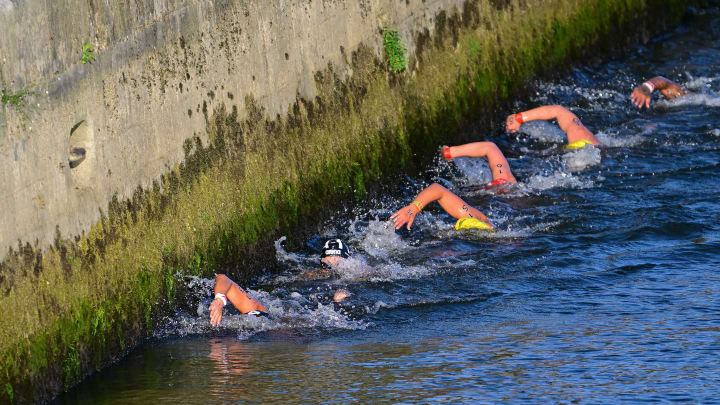Strong Current in Seine River a Tough Challenge for U.S. Open-Water Swimmers

PARIS — On a cool August Thursday morning, the City of Light offered up its finest Olympic eye candy. This was a sight fit for an impressionist painter’s canvas.
The Left Bank was lined with festive fans. The Right Bank was lined with festive fans. Photographers were arrayed across the Pont Alexandre III Bridge, flanked by dramatic gilded statuary. The Grand Palais and its glass roof provided an ornate backdrop. The Eiffel Tower loomed over it all.
The famous brown river at the center of this picturesque scene? Less pristine.
The Seine River, a bathtub of bacteria chosen as the controversial location of the open-water swimming events, put the athletes in the women’s 10-kilometer race through two hours of torment. The hope is that they all exit with nothing worse than fatigue.
After climbing out the turgid water a disappointing 15th, American Katie Grimes is putting her faith in Paris (and probably antibiotics) to have protected those who swam there from getting sick.
“I honestly didn’t think about the water quality that entire time that I was in there,” Grimes said. “It’s just the last thing that was on my mind. But I did swallow a lot of water, so I’m hoping that I’m okay.”
That’s the thing about open-water swimming: swallowing water is unavoidable. There is the rough-and-tumble racing in close quarters, there are waves, and there are the innumerable breaths being taken across a race that long. And when the body of water is as suspect as the Seine … yuck.
Paris Olympic organizers have done a magnificent job of weaving the Games into the beauty and history of the area. The venue choices have been inspired. And while the allure of holding swimming in this famous river that sluices through the city is understandable, it might not have been worth the $1.5 billion investment in cleaning it up. What once was declared biologically dead, in the 1960s, might not have been brought sufficiently back to life.
"While swimming under the bridge, I felt and saw things that we shouldn’t think about too much,” Belgian triathlete Jolien Vermeylen reportedly told a Flemish TV station after competing earlier in the Games. That’s reassuring.
Fluidion, a company charged with monitoring water quality in the Seine before and during the Olympics, has been posting regular updates on its website. After some worrisome results earlier in the week, the data the night before the women’s 10k took a turn for the better.
Fluidion labeled the measurements of pollutants “rather reassuring—looks like water quality is finally stable. … This suggests that sunny weather, low river discharge, lack of rain, and the expensive capture infrastructure built for the Games finally got it right, and the water seems to have been of good quality today!”
The follow-up Thursday morning before the 10k was favorable as well. The competition went on as scheduled, with Sharon van Rouwendaal of the Netherlands winning her third Olympic medal in the event (and dedicating the win to her late dog, who died earlier this year). The top three finishers— Australian Moesha Johnson took silver and Italian Ginevra Taddeucci won bronze—range in age from 26–30.
Grimes and fellow American Mariah Denigan, ages 18 and 21, were 15th and 16th. In a race that favored experience, this was the U.S.’s lowest Olympic finish since the first open-water competition in 2008.
Dirty water was the primary pre-race point of emphasis, but current was the culprit in making the race something Grimes described as “the hardest thing I’ve ever done. Ever.”
Keep in mind that in a span of four days at U.S. Olympic Trials in June, Grimes raced two heats of the 1,500 freestyle, two heats of the 400 individual medley and three heats of the 200 free. So she knows hard.
But coming off a silver medal in the 400 IM and a 10th place finish in the 1,500 last week in the pool competition, adding open water was a big ask for Grimes. When it was over, she looked and sounded like she needed some rest.
The difference between stay-in-your-lane, follow-the-black line orderliness of indoor swimming and the mayhem of open water can be stark. Especially going from pool to river. Denigan described the Seine swim as “definitely the roughest currents I’ve experienced and the toughest race I’ve ever done.”
Grimes said her club team, Sandpipers of Nevada, does its long-distance training in the pool, and there was limited preparation time in the Seine before this competition. Denigan also cited lack of preparation for the current as a problem.
“Our first training session [in the Seine] got canceled [due to water quality] and then the second time we didn’t really want to spend too much time in here risking getting sick before the race,” she said. “So I really didn’t get too much time in here before, but I just wanted to come in, see what it was going to feel like and prepare for the next day.”
What she encountered was a comparatively tight course, with the river banks constricting the swimmers more than in most open-water venues. That also contributed to the current, which Grimes said was about a meter per second. The half-lap, with the current, was in the seven-minute range for most competitors, while the half-laps coming back took 13-plus minutes.
“It’s really unusual to do open water in a river,” Grimes said. “It’s usually in a lake or the ocean, so this was a lot different. I hope I never have to do it again.”
